Table of Contents [hide]
A Shrinking Saab Population: The Alarming Numbers
Saab enthusiasts have long witnessed the gradual disappearance of their beloved brand from Swedish roads. New data from Car.info reveals that as of 2024, 188,528 Saab cars remain registered in Sweden, marking a substantial decline from previous years. Just two years ago, SaabPlanet reported approximately 230,000 registered Saabs, and today, that number has dropped by over 41,000 vehicles. This alarming trend highlights the inevitable erosion of Saab’s presence in its home country.
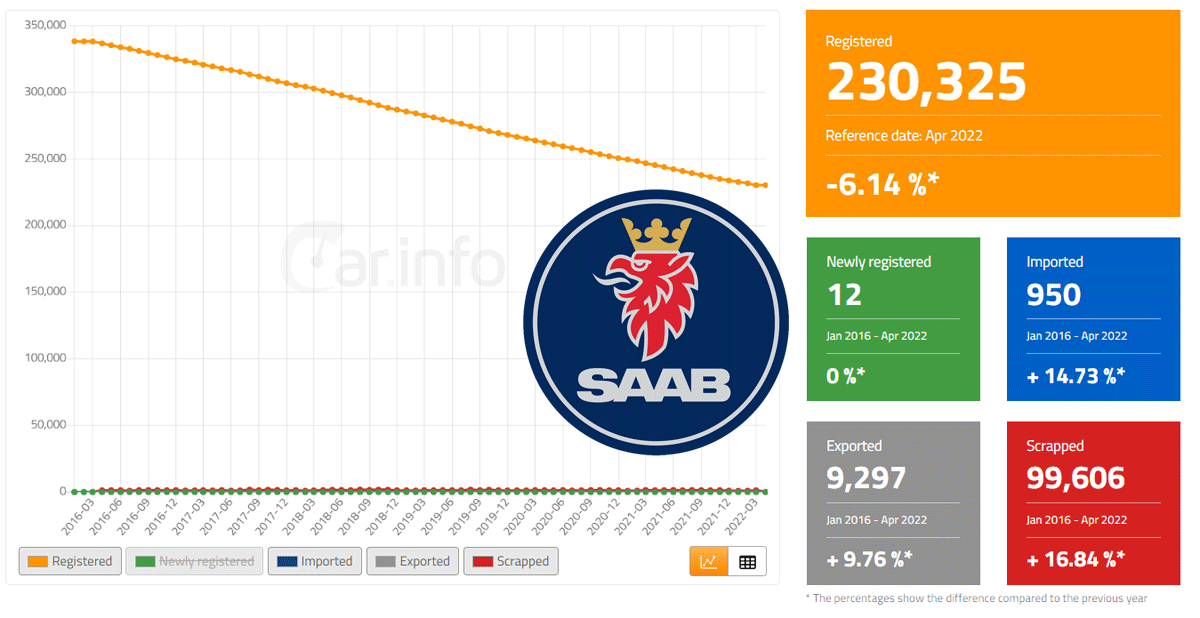
In Norway, the trend is similar but on a smaller scale, with 18,990 Saab vehicles still on the road. The numbers are declining across Scandinavia, reinforcing that Saab’s fleet is steadily diminishing as older models meet their end.
Saab Disappearances: Monthly Scrappage and Export Trends
The key factor behind this decline is simple: Saabs are disappearing faster than they are being replaced. In the past 12 months alone, the total number of Saabs in Sweden has decreased by 5.2%, and over the past five years, the reduction rate has been 5.47%.
While there have been some efforts to preserve the fleet, imports of Saab vehicles remain minimal. In the last five years, Sweden has imported only 643 Saabs, while 4,146 have been exported, further shrinking the local inventory. However, exports are not the primary reason for Saab’s decline—the real culprit is scrappage.
Since January 2020, a staggering 69,438 Saab vehicles have been scrapped, averaging 1,154 Saabs per month. If this trend continues, Saab’s presence on Swedish roads could be critically endangered within the next 16 years.
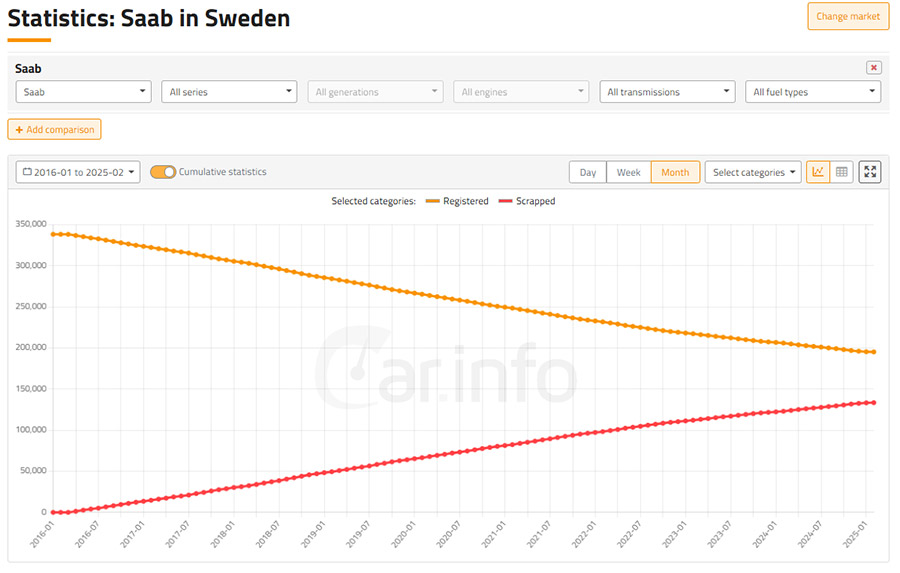
The Most Scrapped and Surviving Saab Models
When looking at the models that have been most affected, it’s the Saab 9-5 (1997-2012) that leads the scrappage charts. The 9-5 has been a workhorse for many Swedish drivers, but as it ages, maintenance costs increase, making scrapping the more economical choice for owners.
Most Popular Saab Models in Sweden
From the series registration data, it’s clear that the Saab 9-3 (1998-2014) is the dominant model, with 73,799 units still on the road. This comes as no surprise given its popularity in both sedan and convertible configurations. Right behind it is the Saab 9-5 (1997-2012), with 63,892 registered units, a testament to the car’s longevity and appeal among enthusiasts.
Beyond these two best-sellers, the numbers drop significantly:
- Saab 900 (1979-1998) – 21,262 still running, proving its iconic status.
- Saab 9000 (1985-1999) – 14,263 registered units.
- Saab 96 (1960-1980) – 10,592 still in circulation, remarkable for a car that ended production over 40 years ago.
On the other hand, the most widely driven Saab model today remains the Saab 9-3 (1998-2014), spanning two generations. Out of the 195,272 total Saabs on Swedish roads, a significant 73,893 are 9-3 models, accounting for 37.8% of the entire remaining fleet. This model’s relatively newer production years and solid aftermarket support have contributed to its slower decline compared to the 9-5.
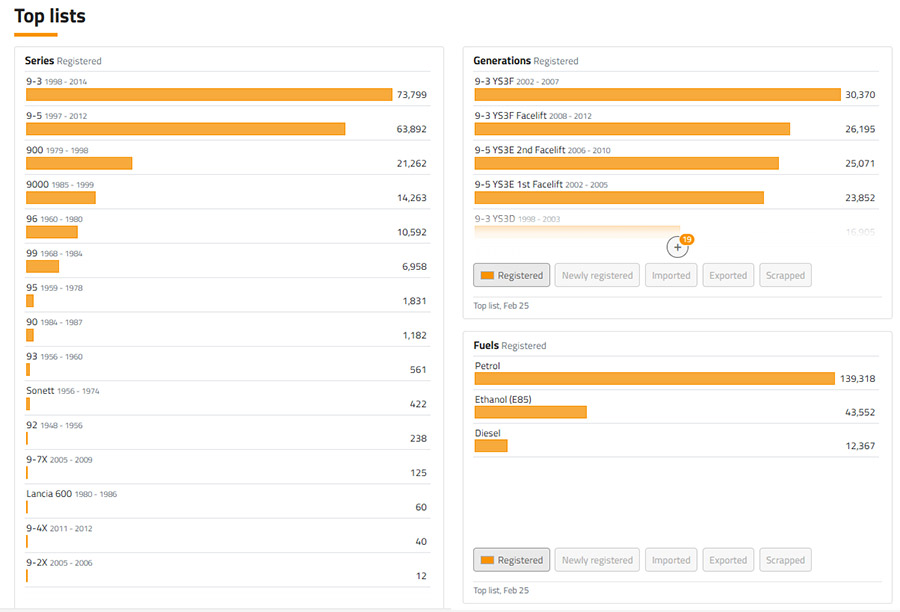
Fuel Types: Saab’s Legacy in Petrol and Ethanol
The table also provides an interesting look at fuel types still in use:
- Petrol-powered Saabs dominate with 139,318 units still on the road.
- Ethanol (E85) Saabs account for 43,552 units, reflecting Saab’s push towards biofuel technology in the 2000s.
- Diesel-powered Saabs are the least common, with just 12,367 registered vehicles, a number that will likely decline further due to Sweden’s tightening emissions regulations.
Generations: Which Models Have Survived the Best?
When breaking down Saab registrations by model generations, the Saab 9-3 YS3F (2002-2007) leads the list, with 30,370 units still on the road. This was the first generation of the GM-era 9-3, widely popular due to its turbocharged performance and safety features.
Other notable survivors:
- 9-3 YS3F Facelift (2008-2012) – 26,195 units, making it the second most registered 9-3 variant.
- 9-5 YS3E 2nd Facelift (2006-2010) – 25,071 registered units, showing that late-production Saab 9-5s are still holding strong.
- 9-5 YS3E 1st Facelift (2002-2005) – 23,852 registered units, proving that the first-generation 9-5 facelift remains a common sight.
The Saab 9-3 YS3D (1998-2003), which marked Saab’s transition into GM ownership, still has 16,905 cars in operation.
The Rarest Saabs in Sweden: Survivors Against the Odds
While mainstream models dominate Saab’s remaining fleet, some rarities continue to exist. Among the most unusual survivors in Sweden are:
- Saab 9-2X – Only 12 remain. Originally a rebadged Subaru Impreza, this short-lived model remains a collector’s curiosity.
- Saab 9-4X – A rare SUV from Saab’s final years, with just 40 still registered.
- Saab-Lancia 600 – One of Saab’s lesser-known collaborations, with only 60 remaining on Swedish roads.
These numbers highlight just how exclusive and valuable certain Saab models have become, with their presence dwindling to near-extinction levels.
The Future of Saab: A Diminishing Yet Passionate Community
The statistics paint a grim picture: Saabs are disappearing at an alarming rate, and without a production line, there is no replenishment of the fleet. However, the passionate Saab community, particularly in Sweden, continues to fight to preserve the brand’s legacy. Enthusiasts are restoring classics, sourcing rare parts, and keeping their Saabs on the road for as long as possible.
Still, the reality remains that Saab is now a brand of the past, and unless scrappage rates slow down, Swedish roads may see fewer and fewer of these iconic cars in the coming decades.







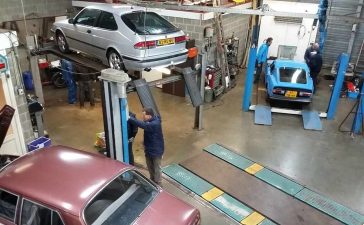

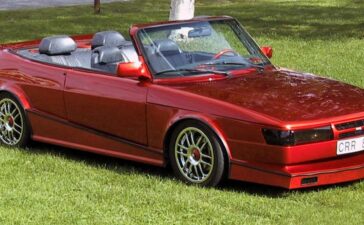


Many of these car uses the Takata airbag and there was´nt a recall on these. Make sure that you don´t drive a car affected by these lethal airbags and you can google it if you don´t know about this issue.
what models? I got a 9-3 OG and I guess I might be safe.
I don’t know. I would not use any of these vehicles with affected steering wheel airbag. I have read about what happened with some of these cars.
Why ban? Sweden is a country full of old cars, it’s part of their mentality and national treasure. If EU ever bans them (what a “democratic” step though) Sweden would be the first to leave and get the independence back.
As a SAAB 99 owner many years ago I would be interested to know how many 99s are still registered
I’m keeping my 900s going here in the states. Are there mechanics that work on them still. It’s getting harder and harder to find them here. And parts.
I have 9-3 1.9 TiD 88kW/120HP, it’s just incredibly reliable and comfortable at going around Europe while having 5L/100Km. Makes driving cheaper than flying. Visited 15 countries.
I was in Sweden last September, there were lots of Saab’s around Trollhattan, ex Saab employees probably. I hardly saw any in the Gothenburg area.
Pity thay don’t still make them
Revival? Quality ! Who will take over and continue the brand and forget electric vehicles.
I wonder how many are still being driven worldwide
There comfortable cars but you need many special tools to fix them by 95k
They needs lots of parts.